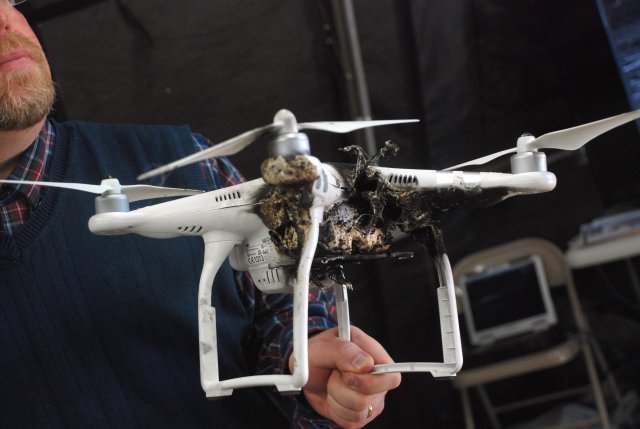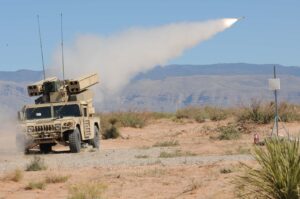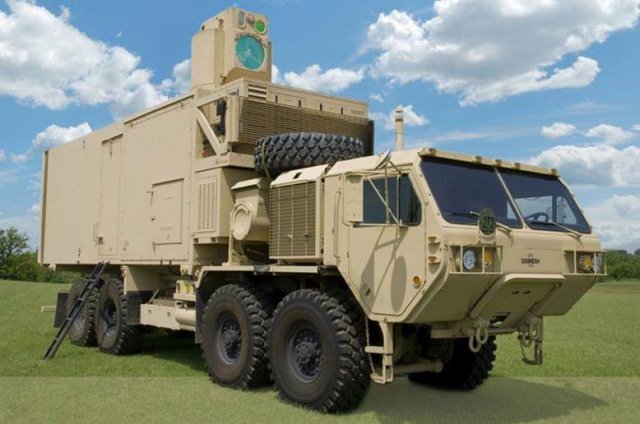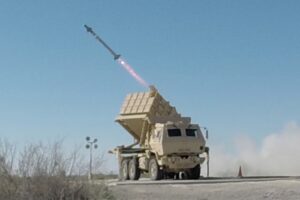Lasers Vs. Drones: Directed Energy Summit Emphasizes The Achievable
Posted on

A quadcopter mini-drone downed by an Army laser in a recent test.
WASHINGTON: When do laser weapons finally become real? The low-hanging fruit for a near-term application looks like it’s shooting down enemy drones before they can target US forces. Both the Army and Marines are testing vehicle-mounted “counter-UAS” (Unmanned Aerial System) lasers, while the Navy already has a bulkier model aboard the USS Ponce in the Persian Gulf.

Maj. Gen. Robert Dyess
How’s it going? Army Maj. Gen. Robert Dyess answered that question by dropping a dead quad copter on the table. Or rather, it used to be a quad copter: After an encounter with a prototype laser, the mini-drone is down to three rotors. At the recent Maneuver Fires Integration Exercise (MFIX) on Fort Sill, Okla., Dyess told the Directed Energy Summit here, a roughly 2-3 kilowatt laser mounted on an eight-wheel drive Stryker armored vehicle shot down 35 such drones.
The Army also has a heavy truck mounting a higher-powered 10 kW laser, now being upgraded to 50-plus kW. Meanwhile the Marines, who put a higher priority on lightness and mobility, are working on a 30-kW laser mounted on a Humvee (or, in the future, a JLTV), called Ground-Based Air Defense (GBAD).
These short-ranged, relatively low-powered weapons fall far short of the megawatt-plus space-based lasers envisioned by Ronald Reagan 32 years ago. Their targets — small drones flying low and slow — are likewise both less difficult and less dangerous than nuclear ballistic missiles. But Reagan’s vision far outstripped the technology of the time. Three decades later, the proposed mission has gotten easier, and the technology has gotten better, until now they’re meeting in the middle.

Gen. Ellen Pawlikowski
“Instead of going after things that were going to require megawatts of power, we looked at things that would potentially require only tens of kilowatts,” said Gen. Ellen Pawlikowski. She’s head of Air Force Material Command and former program director of the megawatt-class Airborne Laser (ABL), cancelled in 2011 after its first successful test.
“We calibrated our expectations in terms of the target” the laser was supposed to defeat, Pawlikowski said. As a result, she told the Directed Energy Summit, “I think we are at the point that we can now earn our way onto these platforms, if we are very careful about not overselling.”
Fortuitously, laser technology is reaching the point where it can down drones just as drones are becoming a real threat to US forces. Once an American monopoly, small unmanned aircraft have proliferated not just to major powers like Russia and China but to militias like Iran-backed Hezbollah and even to the shelves of Walmart. All are inherently capable of reconnaissance, since the operator must have some kind of camera to see where he or she is going. Many could potentially carry weapons, if only as jury-rigged “flying IEDs.” And in the hands of professional soldiers like the Russians, drones can spot targets for sudden, devastating artillery barrages, as demonstrated bloodily in Ukraine.

An Avenger Humvee launches a Stinger anti-aircraft missile.
What’s worse, the US dissolved most of its Short Range Air Defense (SHORAD) capability since the Cold War. After all, commanders could count on the Air Force to sweep the skies of Serbian or Iraqi aircraft. Against a Russia or China, however, sophisticated anti-aircraft missiles might keep American aircraft at bay and leave US ground forces vulnerable to surveillance and attack. In any scenario, drones are a more likely threat than traditional manned fighters because they’re cheaper and — being low, slow, and small — harder to detect.
Today, the Army is down to just two active-duty SHORAD battalions and two independent batteries, officers said at a Center for Strategic & International Studies panel yesterday. These units are armed either with Gatling guns — Navy Phalanx systems repurposed to shoot down mortars in Iraq — or aging Stinger anti-aircraft missiles. Neither weapon is well suited to shoot down drones. Speaking to reporters at the directed energy conference, Marine Corps Combat Development Command chief Lt. Gen. Robert Walsh openly doubted a Stinger could even detect the smallest drones.

Mark Gunzinger
So while going after drones instead of ICBMs is in part a matter of pragmatically lowering expectations, it also responds to a real need.
“It’s lower hanging fruit, (but) it’s also an acknowledgment of the growing threat,” said Mark Gunzinger, a retired Air Force officer and laser expert at the Center for Strategic & Budgetary Assessments (CSBA), which co-sponsored the conference with Booz Allen Hamilton.
“It’s not a fad,” Gunzinger told reporters. “It’s based on where the community sees the threat going and the potential for direct energy to actually have effects against those kinds of systems.”

Army HEL (High Energy Laser) Mobile Demonstrator
Lasers On Trucks
The Navy’s led the way on lasers, as we’ve previously reported, in part because of forward-thinking leaders and in part because a ship simply has a lot more room to accommodate a bulky prototype. Now the Army and Marines are advancing rapidly with lasers mounted on ground vehicles.

Lt. Gen. Robert Walsh
The two ground forces have different needs and different approaches, however. As an amphibious expeditionary force, the Marines need something light enough to get ashore easily and mobile enough to keep up with combat units. That’s why their 30-kW laser is mounted on a Humvee, Lt. Gen. Walsh explained. While next year’s GBAD demonstration will require the vehicle to come to a full stop before shooting, Walsh went on, the longer-term goal is a laser that can fire on the move.
Keeping with the theme of modest expectations, Walsh emphasized that the laser would only solve part of the problem at first. Against manned aircraft — and even larger, higher-altitude “Class IV” drones — GBAD will initially use the old Stinger missile, mounted alongside the laser on the same vehicle. As time goes on, however, Walsh expects the laser to become more capable and take on ever harder targets, gradually reducing dependence on the Stinger until the missile can be phased out.
The Army likewise wants to use lasers alongside missiles, not instead of them. The service’s SHORAD solution is called IFPC, the Indirect Fire Protection Capability. First-generation IFPC actually doesn’t include a laser at all: It combines existing sensors and a command network called IBCS with a Multi-Mission Launcher (MML) able to fire a wide variety of existing missiles. IFPC and the wider IBCS network, however, are being built to easily accommodate future upgrades, including a laser weapon.

Army Indirect Fire Protection Capability (IFPC) test-fires an AIM-9X missile.
The Army is putting less emphasis on mobility than the Marine Corps: IFPC isn’t designed to fire on the move. Instead, at least initially, IFPC units will have to stop and set up their sensors and weapons to protect a static target, such as a command post or a munitions dump. The Army has many such targets to worry about defending because it provides the communications and supply infrastructure to support not just its own forces but much of the other services’ as well. Mobile combat forces, however, would be protected only as long as they stayed under IFPC’s umbrella: As they advanced, IFPC wouldn’t easily be able to keep up.
In the slightly longer term, both the Army and Marines want to upgrade their lasers to counter rockets, artillery, and mortar shells (C-RAM). Those are faster-moving, tougher targets that mini-drones, but like drones they are an increasing threat as precision-guidance technology spreads to potential enemies. Meanwhile the Air Force wants to put lasers on Special Forces AC-130 gunships to silently disable enemy vehicles and communications from the air. Only after tackling more attainable targets will lasers turn their sights on Reagan’s old objective: shooting down incoming missiles.
Subscribe to our newsletter
Promotions, new products and sales. Directly to your inbox.
